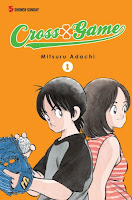 Creator: Mitsuru Adachi
Creator: Mitsuru Adachi
U.S. publisher: Viz Media
ISBN: 9781421537580
Released: October 2010
Original release: 2005-2006
Awards: Shogakukan Manga Award
For some reason, I have been very reluctant to read Mitsuru Adachi’s manga series Cross Game. I’m not sure if it’s because the series is a sports manga or what. I’ve heard plenty of good things about Adachi and about Cross Game in particular, even from readers who aren’t particularly fond of baseball. I even read a preview of the series in Otaku USA and enjoyed it, but for some reason still couldn’t bring myself to read more of the series. My hand was finally forced when Cross Game was selected for the May 2011 Manga Moveable Feast. Because of that, I picked up the first volume released by Viz Media in 2010—equivalent to the first three volumes published in Japan between 2005 and 2006. Adachi began the series in 2005 and the seventeenth and final collected volume was released in Japan in 2010. In 2009, Cross Game was honored with a Shogakukan Manga Award. There was also a fifty episode anime adaptation of the series produced between 2009 and 2010.
The Tsukishima family, who run the local batting cages and the Clover coffee shop, and the Kitamura family, who own the sporting goods store down the street, are good friends and their children have grown up together. Wakaba, the Tsukishima’s beloved second daughter (out of four) and Ko, the Kitamura’s only son, are particularly close and even share the same birthday. It seems like fate that the two of them should be together. The only person who’s unhappy with the two being nearly inseparable is the next youngest Tsukishima daughter, Aoba. She adores Wakaba and so holds a grudge against Ko. Although Aoba won’t admit it, except for the fact that she loves baseball and Ko isn’t even really interested in the game, she actually shares quite a lot in common with him.
While there are moments in Cross Game that are absolutely heartbreaking, the manga also has quite a bit of light-hearted humor to it as well, making the series more touching rather than depressing. Ocassionally, Adachi does have the tendency to either break the fourth wall or come very close to it. I did find this amusing, but it also threw me out of the story. However, I really enjoyed the small bits focusing on the Tsukishima’s pet cat Nomo; they made me smile every time. Adachi’s art style is fairly simple and straightforward. Every once in a while it feels like the panels are a bit disjointed, usually when Adachi sets up a dramatic reveal, but overall it is very easy to follow. One thing that he does that I particularly enjoyed and appreciated is how he captures the passage of time, often using the changes in season and in the neighborhood to visually transition from chapter to chapter. This also helps to establish a sense of place and makes the town feel as well-rounded and complete as the characters.
Although there is plenty of personal drama, conflicts, and lively baseball games, I mostly find Cross Game to be a rather quiet coming of age series. Out of this volume, I preferred the first part of the story which focuses a bit more on the relationships between characters than on the baseball. But even when baseball becomes more prominent in the manga, the character interactions remain crucial and convincing. There is something subtle and very skilled in how Adachi balances the two elements. That being said, I find it strange that I’m not more gung-ho about Cross Game; for some reason it just doesn’t immediately grab me. However, I did appreciate it more and more after repeated readings. I truly care about the characters Adachi has created, even if I don’t feel compelled to immediately rush out and read more of the manga. But, I’ve discovered that the longer I wait, the more I worry about the characters and wonder how they are doing.








